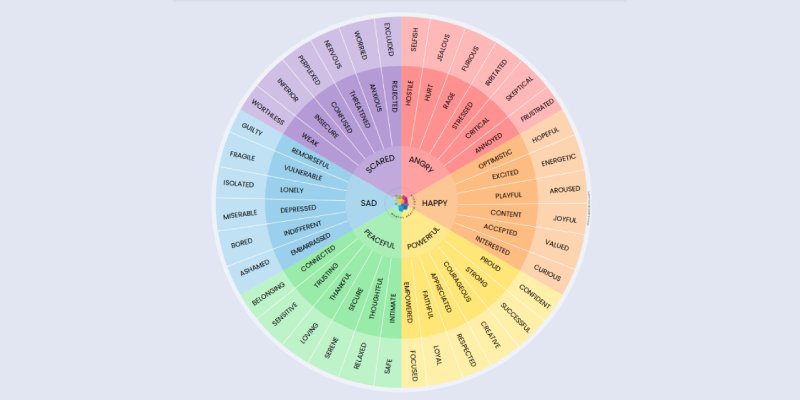Emotions can be complicated and, at times, overwhelming. Navigating through our feelings can be like trying to find our way through a labyrinth – it’s easier when we have the right tools. Enter the Feelings Wheel, a powerful tool for understanding and processing our emotions. This tool can significantly increase self-awareness, enhance emotional communication, and, consequently, boost our overall mental well-being.

The Feelings Wheel, conceptualized by Dr. Gloria Willcox, helps us articulate our emotions and tend to our mental health more effectively. It organizes our emotions—primary, secondary, and tertiary—into several categories and subcategories, effectively allowing us to pinpoint exactly what we’re feeling. This can be particularly beneficial when we’re overwhelmed or engaged in a tense situation.
The Power of the Feelings Wheel
Let’s put the Feelings Wheel to work. Imagine you’re feeling frustrated and angry. The Wheel helps you explore these feelings more deeply. You might realize that your anger is rooted in feelings of frustration, annoyance, and resentment (secondary emotions). Digging further, you might uncover more specific feelings of impatience, exasperation, or agitation (tertiary emotions). By helping you name your feelings, the Wheel validates your emotional experiences, thereby fostering a sense of empowerment and encouraging you to manage your emotions without judgment.
One of the significant benefits of using the Feelings Wheel is its ability to facilitate effective communication. Clear and accurate communication of feelings is crucial in forming and maintaining healthy relationships. The Feelings Wheel allows us to articulate our emotional states accurately, enabling those around us to respond empathetically.
Additionally, the Wheel encourages mindful reflection, allowing us to identify emotional patterns and triggers. As we explore the various emotions housed within the Wheel, we might uncover feelings we were previously unaware of. This increased self-awareness can provide insight into our thoughts and behaviors, helping us better regulate our emotions.
The Feelings Wheel also plays a pivotal role in therapy and mental health treatments. It allows therapists to facilitate discussions about emotions and aids in teaching clients about emotional intelligence and coping strategies. This culminates in more effective therapeutic outcomes.
Lastly, as we engage with the Wheel, we develop a broader perspective on emotions, helping us empathize and support others more effectively.
Leveraging the Feelings Wheel
How can you start harnessing the power of the Feelings Wheel? Here are some steps you can follow:
- Download the Feelings Wheel. The first step is to familiarize yourself with the Wheel. Download it, study it, and reflect on each word. Coloring in the Wheel can be a fruitful exercise in contemplation.
- Check-in with yourself. Next, take a moment to check in with yourself. What are you feeling right now? Try to identify your emotions using the Wheel. This heightened emotional awareness can foster healthier self-expression and communication.
- Communicate your feelings. Once you’ve identified how you’re feeling, start articulating your emotions, either to yourself or someone in your support system. The Wheel provides a common language for describing emotions, enhancing communication and understanding.
- Take appropriate action. Finally, use your newfound understanding of your emotions to take appropriate action. By uncovering the underlying causes of our feelings, we can manage our emotional responses more effectively, promoting thoughtful and measured responses.
Ultimately, the Feelings Wheel acts not just as a visual representation of emotions, but as a practical tool for developing emotional intelligence. Whether you’re journaling your feelings, communicating with loved ones or simply trying to understand yourself better, the Feelings Wheel can be a valuable companion on your journey towards emotional awareness.
Would you like a free Feelings Wheel and worksheet? Click here.

